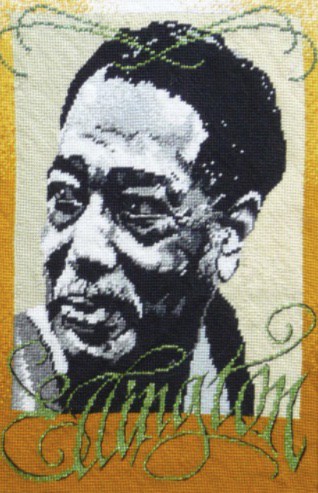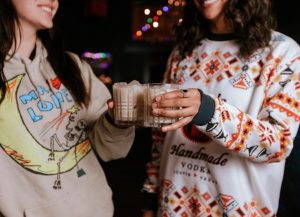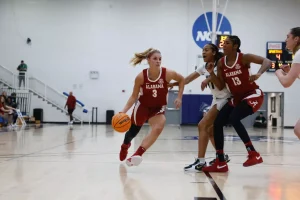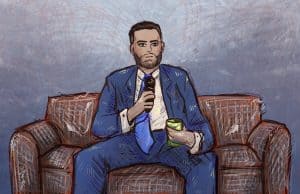‘Shaken by the Roots’: Needlepoint artist highlights jazz greats

Duke Ellington (Needlepoint artwork by Leanna Leithauser-Lesley)
February 13, 2022
For Birmingham fiber artist Leanna Leithauser-Lesley, needlepoint art is a childhood hobby-turned-passion that has deepened her connection to her Southern heritage.
As a self-described “avid needlepointer,” Leithauser-Lesley aims to create an understanding of needlepoint as an art form through her affinity for jazz music and civil rights history.
Her current exhibit, titled “Shaken by the Roots,” juxtaposes erratic, uninhibited jazz music with portraits done in needlepoint, an art form that requires structure and steadiness. The exhibit features nearly her entire collection of works and is on display at the Dinah Washington Cultural Arts Center in downtown Tuscaloosa.
Leithauser-Lesley’s needlepoint portraits include jazz greats Duke Ellington, Billie Holiday and Sun Ra, among others. Many hail from Alabama. The exhibit showcases a tapestry centered around Dinah Washington, a Tuscaloosa-born blues musician and the gallery’s namesake.
Some pieces hang on the gallery walls, while others are stitched into the backs of chairs, mixed into tapestries and quilts, or sewn together to form a dress modeled on a mannequin.
Leithauser-Lesley said she listens to the music of the artist she is stitching while she works on their portrait to better capture their essence.
“I think [the music] gets into the yarn somehow,” she said.
Gallery director Daniel White said needlepoint is often overlooked due to its reputation as a craft rather than a form of expression. Many artists who visit the exhibit, however, are impressed.
“I think maybe for artists and for people that needlepoint, they understand how labor intensive the work is. … It takes time, and planning and execution,” White said.
Aidan Miles-Jamison, a junior majoring in art history at The University of Alabama who works at the gallery, said that viewing the exhibit is a unique opportunity for art students, as the University does not offer fabric art classes.
“I think that’s a really good resource for a lot of us art or art history majors to see such high skill level and high technical ability in that art form,” Miles-Jamison said.
Leithauser-Lesley said her passion for needlepoint started at the age of 8, when her grandmother taught her in an effort to get her to sit still. She began learning the art form in a traditional way by stitching images onto pre-designed canvases with matching yarn.
In college, Leithauser-Lesley stitched her friends’ favorite album covers onto pillows for their dorm rooms. But these album covers never belonged to jazz artists.
In fact, Leithauser-Lesley never listened to jazz in her youth, and it wasn’t until the director of education at the Birmingham Civil Rights Institute asked her to create an exhibit based on jazz musicians that she considered focusing on the genre.
At first, Leithauser-Lesley declined the institute’s offer.
“They said ‘Why?’ and I said ‘Because it’s not my story to tell. I don’t know anything about jazz,’” Leithauser-Lesley said.
The director of education persisted and sent Leithauser-Lesley to speak to Frank Adams, who was serving as the director of the Alabama Jazz Hall of Fame. He convinced her to take on the responsibility of telling the story of Black musicians in the South.
“I felt like if I did what they asked me to do, I would be an impostor,” Leithauser-Lesley said.
Adams made her feel comfortable with the subject of her art. Although reluctant at first, Leithauser-Lesley met with Adams almost every Tuesday for a year to gain a better understanding of the societal issues of the South during the civil rights era and how those struggles are expressed in the music of the time.
Adams died in 2014, but Leithauser-Lesley said he was an engaging and supportive educator, and an incredible musician. At the premiere of her exhibit with the Alabama Jazz Hall of Fame, Leithauser-Lesley remembers Adams stopping at every piece she created, speaking about the featured artist briefly and playing a piece of each musician’s work on his clarinet.
“He changed my life. I didn’t realize it at the time, and I regret it,” Leithauser-Lesley said.
Leithauser-Lesley’s feelings about jazz have transformed from her initial reluctance, and now the music and history are both integral to her passion for her work and her understanding of Southern culture.
“I feel completely and utterly, 100% connected to it. I feel like I have the right to tell the story. I feel like I have done my research. I mean, I live it. I listen to it every day. I mean, it has become a part of who I am, so it’s become much more authentic to me now than it used to be,” Leithauser-Lesley said.
“Shaken by the Roots” will be on display at the Dinah Washington Cultural Arts Center until Friday, Feb. 25.
Questions? Email the culture desk at [email protected].









